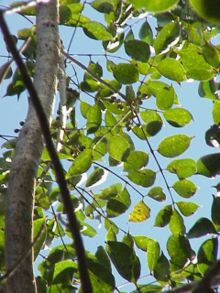Burseraceae
| Burseraceae | |
|---|---|
 |
|
| Bursera simaruba (Gumbo-limbo) | |
| Scientific classification | |
| Kingdom: | Plantae |
| (unranked): | Angiosperms |
| (unranked): | Eudicots |
| (unranked): | Rosids |
| Order: | Sapindales |
| Family: |
Burseraceae Kunth |
| Genera | |
|
See text. |
|
See text.
The Burseraceae are a moderate-sized family of 17-19 genera and about 540 species of flowering plants. The actual numbers differ according to the time period in which a given source is written describing this family. The Burseraceae are also known as the torchwood family, the frankincense and myrrh family, or simply the incense tree family. The family includes both trees and shrubs, and is native to tropical regions of Africa, Asia, and the Americas.
Just as the family size (in terms of genera and species) differs according to the time period of the study, so, too, does its placement in the higher ranks. Nevertheless, the family is a genetically supported monophyletic group currently and frequently cited within the Sapindales and is recognized as a sister group to the Anacardiaceae.
The Burseraceae are characterized by the nonallergenic resin they produce in virtually all plant tissue and the distinctive smooth, yet flaking, aromatic bark,. The origins of the family can be traced to the Paleocene (about 65 Mya) when Beiselia mexicana first diverged in Mexico. The subsequent divergences in the family lineage and migration of the species in the Eocene (53 Mya) from North America have led to the current distributions of the species that are primarily associated with the tropics. Though the family likely originated in North America, the greatest generic diversity presently is in the Southern Hemisphere.Tabonuco (Dacryodes excelsa) and gumbo limbo (Bursera simaruba) represent the economic, ethnobotanical, and ecological significance of the Burseraceae in the Western Hemisphere, while frankincense (Boswellia sacra) and myrrh (Commiphora myrrha) represent the same in the Eastern Hemisphere.
The Burseraceae trees or shrubs are characterized by resins (having triterpenoids and ethereal oils; that are present within the plant tissue from the vertical resin canals and ducts in the bark to the leaf veins. In fact, the synapomorphy of the Burseraceae is the smooth yet peeling or flaking aromatic bark. The clear, nonallergenic resins may smell like almonds, but at least the most well known resins, frankincense and myrrh, have an odor that is distinct from almonds, smelling like incense. The leaves are generally alternate, spiral, and odd-pinnately compound with opposite, frequently long-petiolulate, entire to serrate, pinnately veined leaflets whose symmetry is distinctive in some genera. However, some members are known to have trifoliate or unifoliate leaves. The leaf and leaflet stalks and axis may be brown and scurfy, while the leaf base is swollen and may be concave adaxially. The family members tend to be without stipules. The determinate, axillary inflorescences carry small, radial, unisexual flowers. The plants tend to be dioecious. The flowers may have four or five faintly connate but imbricate sepals with an equal number of distinct, imbricate petals. Also, the stamens, that may contain nectar discs, have distinct glabrous that occur in one or two whorls and in numbers equaling or twice the number of petals; the tricolporate pollen is contained within two locules of the anthers that open longitudinally along slits. The gynoecium contains 3-5 connate carpels, one style, and one stigma that is head-like to lobed. Each locule of the superior ovary has two ovules with axile placentation that are anatropous to campylotropous. The one- to five-pitted fruit is a drupe that opens at maturity. The endosperm is usually lacking in the embryo.
...
Wikipedia
